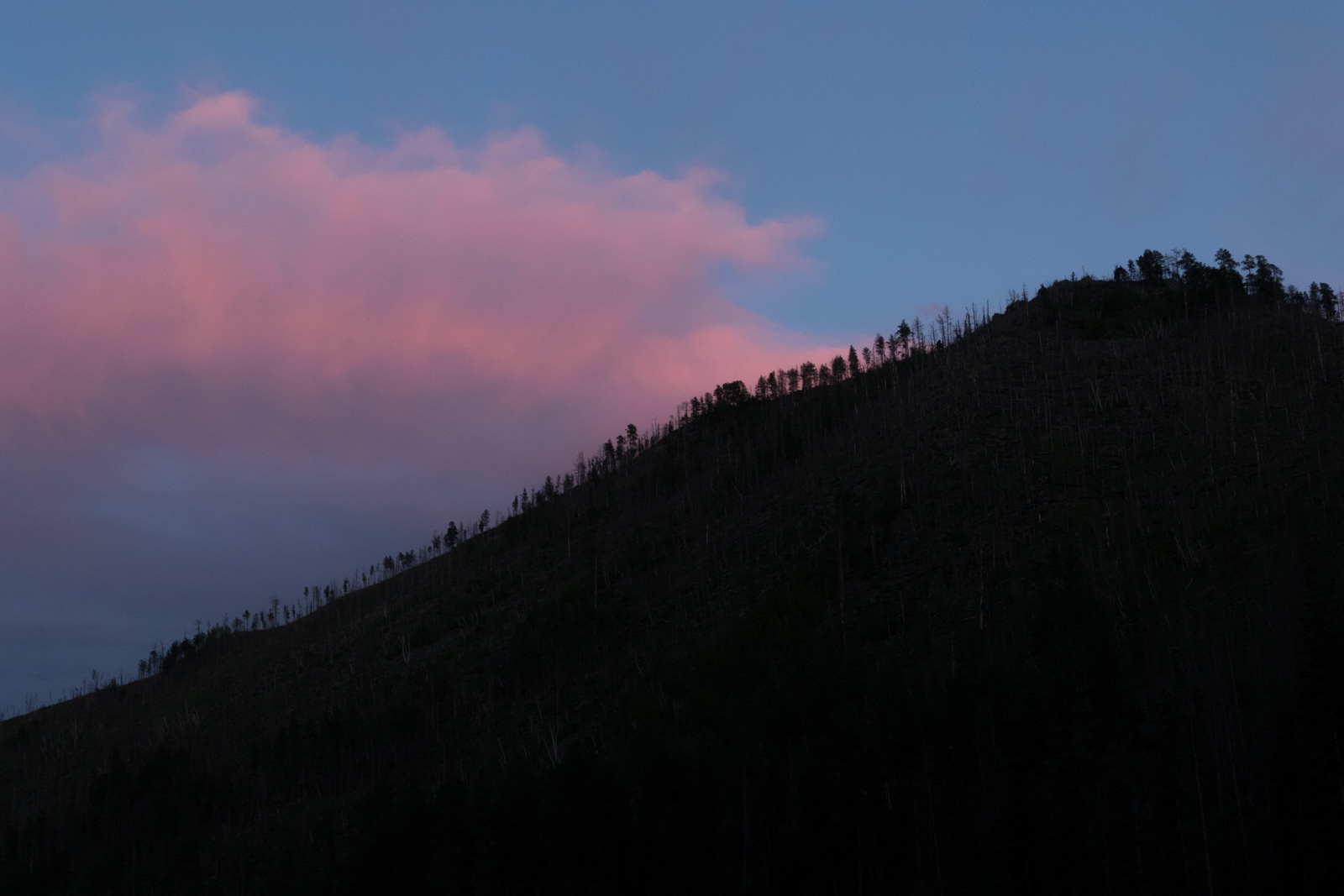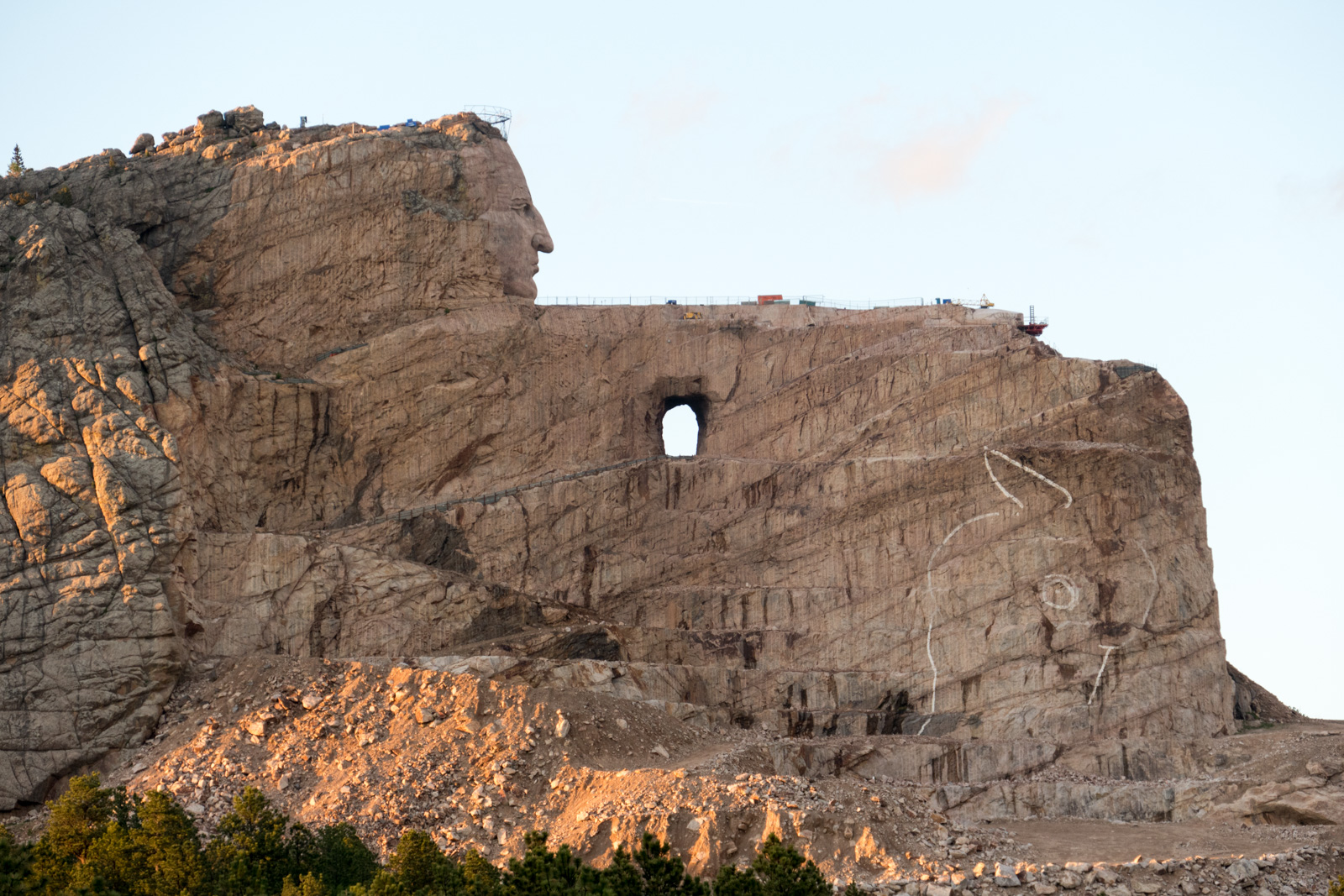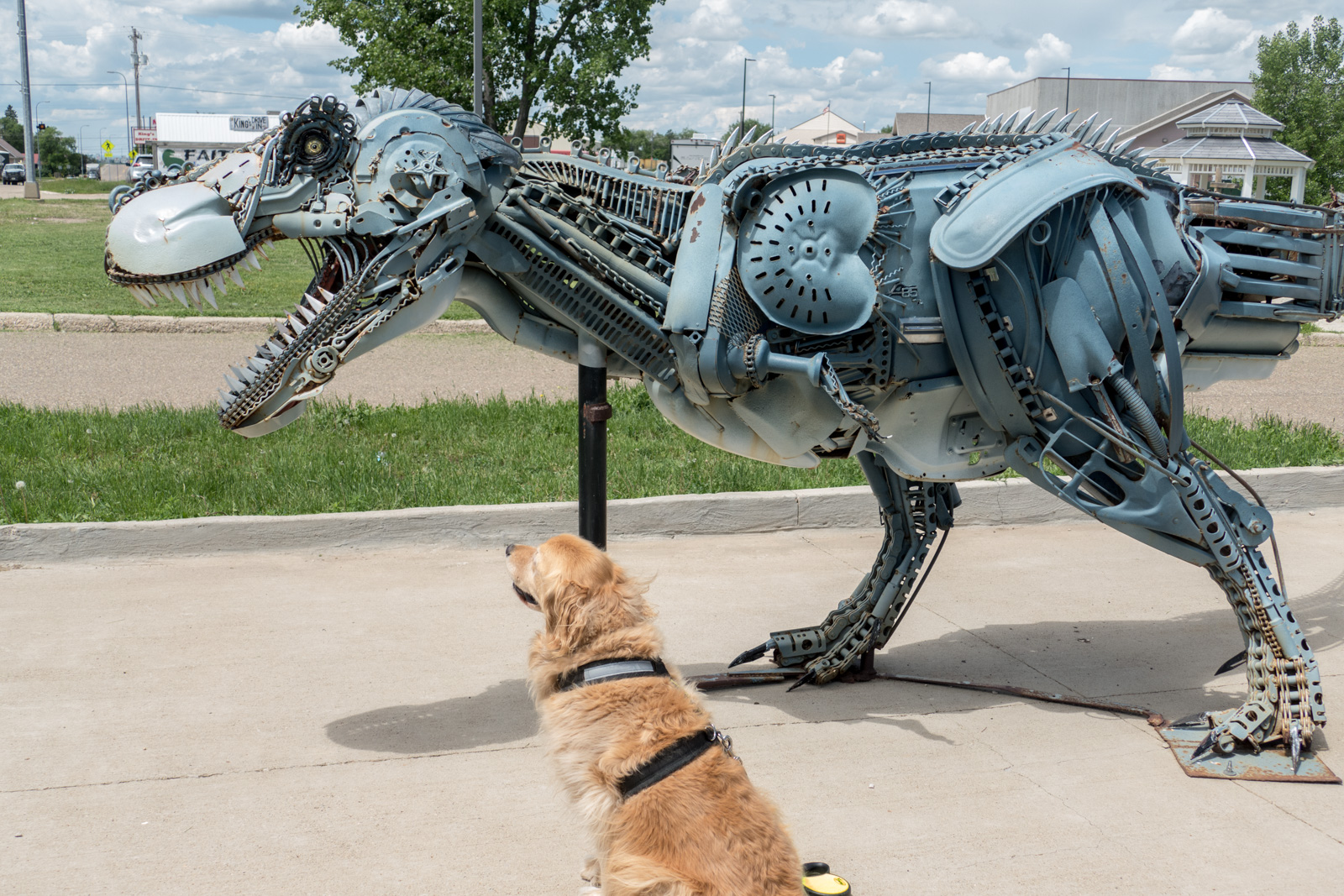Badlands or bust
In June of 2019 we took a two-week road trip with Maple to drive the back roads to Rapid City, SD and back. The primary targets were the Badlands, Black Hills, Custer State Park, and Devil's Tower. On the way out we made stops in Iowa City (to see the Devonian Fossil Gorge), Amana Colonies, Pella, Winterset (Bridges of Madison county), Des Moines, and Chamberlain, SD. On the return trip we were in more of a hurry and there’s also less to see in the northern part of SD.so we only made stops in Faith, SD and Granite Falls, MN following an Airbnb farm stay in Clarkfield, MN.
Devonian Fossil Gorge
This is what remains of the campground following the two floods which moved huge rocks and sediment that revealed the fossils in the old sea bed.
In Iowa City the Devonian Fossil Gorge is an interesting spot to visit, especially if you like fossils (and who doesn’t like fossils?). The floods of the Mississippi River drainage of 1993 and 2008 wiped out a campground below the dam and spillway. The interesting thing about this gorge is that one can wander around and easily see fossils in the rocks. You are not allowed to remove any fossils, and the good ones are in the small museum. At the time that we visited there was major flooding in IA, NE and SD but Iowa City was not affected. Water levels were definitely high and we saw many corn fields under water.
With the high water levels the torrent of water in the spillway to the dam was very impressive. One can just imagine what it was like to have enough water to overflow the top of the dam.
Fossil in the rock
Fossils in the rock
Amana Colonies
We arrived at the Amana colonies too late to visit any of the shops so we wandered around the town before having dinner at the Ox Yoke Inn. The colonies were founded in the 1850s by a German religious sect similar, but different from the Amish. For many years they maintained a communal society with communal kitchens and hand industries that were largely independent of industrialized America. During the Great Depression, though, they were in financial crisis and became incorporated. They were well-known for Amana Applicances, which made some of the first refrigerator units for home use. They were also known for hearty home-style German cooking which we sampled.
Pella, Winterset, and Des Moines, IA
Jaarsma Bakery
After spending the night in an Airbnb in Belle Plaine, near the Amana colonies, we drove to Pella for breakfast. We had heard about Pella and its famous bakery on our previous road trip to Santa Fe when we went to its branch store in Oskalooska. Pella is well-known for maintaining its Dutch origins with a famous tulip festival. The downtown square has a windmill and has a quaint European feel. The Jaarsma bakery is so popular that it is designed to accommodate a crowd. You go in one door to stand in line and when you finish your shopping, you exit another door. The problem for us was that there was no where to sit and eat the pastries that we had bought. I had been hoping to sit and have a cup of coffee with the baked goods. Fortunately there is a coffee shop nearby and they didn’t mind if we bought their coffee and ate our pastries.
Next stop was to drive to the area famous for the Bridges of Madison County. The bridges are centered near the town of Winterset and we spent most of our time visiting the Holliwell Bridge. We wanted to also visit the Living History Farm near Des Moines before it closed so we had to hurry to make it there. We made it in time for Lil to visit for about an hour while Maple and I exercised outside.
In the town square of Pella
Please leave your shoes at the door
Windmill in Pella
Holliwell Bridge near Winterset, IA
Chamberlain and eastern SD
Chamberlain, SD, where I-90 crosses the Missouri River, is a worthwhile stop. We were not on the interstate but we came here to see the Lewis and Clark Interpretive Center which has the large 50-foot statue of a Native American woman commemorating the Lakota and Dakota tribes that inhabited this land before Lewis and Clark opened it up to white settlers. There is also a nice overlook of the river. Unfortunately we arrived just after the Center had closed so we didn’t get a chance to visit it. The location of the Center is a bit confusing since it is labeled as a rest stop and there’s no sign saying that it is one of the Lewis and Clark Interpretive Centers. We actually drove up and down I-90 for an exit in either direction before my traveling companion was satisfied.
There are several good reasons to make this a stop on your way through SD. First, of course, is the interpretive center that supposedly has a keel boat of the type used in the expedition. Second, there is a very nice overlook of the Missouri River. Finally, just outside the Center, is a tall metal statue which I originally thought was of Sacagawea, the Indian woman who was the only woman on the Lewis and Clark expedition. It turns out that the statue commemorates the Native American tribes that were displaced by the white settlers, an ugly chapter in American history. There is also a Lakota Cultural Center in the town of Chamberlain, which we went to visit but found that we were also too late to visit it. We considered retracing our path on the return trip to Madison just so we could visit the Interpretive Center and the Cultural Center but in the end decided to see new ground. We’ll have to leave visiting these centers for the next trip.
Driving on the backroads instead of the Interstates is, of course, slower, primarily because one has to slow down as you pass through the towns. The roads themselves are much easier to drive since there is less traffic, especially no trucks. So passing on the two lane roads is usually not a problem, especially in Iowa and SD where it is also very flat. With the open roads one also can imagine what it was like for the early settlers to come along on their wagon trains under the big sky.
The Destiny statue that overlooks the Missouri River at the Lewis and Clark Interpretive Center in Chamberlain, SD
Panoramic overlook of the Missouri River at Chamberlain, SD
The big skies of South Dakota
Part of our journey followed the Deadwood trail from Fort Pierre to Deadwood, SD
Making hay on the plains
Badlands
We had perfect weather when we were visiting the Badlands, which I remember as being brutally hot in the summertime in my youth. This time the weather was warm during the day and cool at night. We camped in one of the campgrounds just outside the park.
Panorama of the Badlands
Panorama of Badlands
Panorama of Badlands
Bison grazing in the distance at sunset
This couple came prepared to enjoy the sunset
A tourist site in the ‘town’ of Scenic, SD
The other tourist site in the ‘town’ of Scenic, SD
Black Hills
Probably most people come to the Black Hills to see Mt. Rushmore with its iconic images of four great American Presidents. While the massive sculptures are undeniably arresting, the town of Keystone, which is the gateway to Mt. Rushmore has become a tourist’s quagmire with all kinds of fake attractions (Wax museums, Adventure park, mini-golf, reptile garden, horseback rides, etc.) to try to separate visitors from their money. On the other hand, the nearby Iron Mountain and Needles roads are spectacular drives and worthwhile to see and appreciate the scenic Black Hills. The Iron Mountain road was built under the direction of Peter Norbeck, Senator from SD, and designed by C.C. Gideon. They wanted to show off the scenery and majesty of the area by making the road winding and narrow to force motorists to drive slowly. Furthermore they put in unique ‘pigtail curves’ and tunnels, one of which frames the Mt. Rushmore images. The Needles road has several very narrow, one-lane tunnels that you might have to fold in your side rearview mirrors if you’re driving a dinosaur.
A tunnel on the Iron Mountain Road which frames Mt. Rushmore.
Cathedral spires at sunset
View of the Needles Tunnel through the windshield.
The Needles Eye Tunnel, the narrowest of the tunnels on the Needles drive.
Silhouettes at sunset outside Hill City
Mammoth Site
Near Hot Springs, SD is a fascinating active paleontological excavation site and museum of mammoths, mostly Columbian with a few of the smaller woolty mammoths. It is believed that the mammoths fell into a sinkhole and were unable to get out. Curiously all of the mammoths are young males, which they interpret to mean that the young bucks are more curious and less cautious than others of the species. Many of the fossil mammoths are still buried in the rock and they are in the long process of separating the fossils from the rock. The site was discovered when they were in the process of leveling a hill for a housing development and came across many bones. Luckily, the developer had a sense of the importance of the discoveries and eventually sold the land back to the public. Interesting to speculate on how many of us are living atop similar piles of fossils.
Maple is not impressed with the mammoth.
Flora and fauna of the Badlands and Black Hills
While driving through the park, there were numerous occasions when bighorn sheep could be seen resting on the plateaus. Most of the sheep were shedding their winter fur so they didn’t look as majestic as they could be. Also many of them were wearing radio collars so they must be keeping track of the herds. Most of the bison we saw were near the Wildlife Loop in Custer State Park. The other common wildlife in both the Badlands and Black Hills were prairie dog colonies, which were often seen on the side of the road. Maple got quite excited when we stopped to watch the prairie dogs, as they popped up and down from their holes and scurried across the ground. She also barked, which she very rarely does, at the bison when they were close to the car but the bison were unfazed.
Bison calf
Bighorn sheep
Badlands tableau
Prairie dog on alert
Bighorn sheep
Big Horn sheep closeup with backlit whiskers
Bighorn sheep chewing her cud
Prairie dog
Prairie dog in mid-call
Salsify
Crazy Horse Memorial
The giant mountain sculpture was begun in 1948 and is far from completed. It is located about 15 miles from Mt. Rushmore and was conceived as a counterpoint to the white man’s heroes by the Oglala Lakota chief Henry Standing Bear who commissioned Korczak Ziolkowski for the project. Ziolkowski died in 1982 at the age of 74 after which it was undertaken by his wife and subsequently by his children and grandchildren. The project is controversial, even among the Lakota, since the mountains and land are considered holy .
Note the drawings of the horse’s head on the mountain rock.
The model of the Crazy Horse Memorial statue in the foreground with the work in progress in the background.
Devil’s Tower
On our last day we drove into WY to visit Devil’s Tower which is about 50 miles from Spearfish, SD, making it an easy day trip. The tower is a spectacular sight, rising some 1200 feet above the nearly flat plains. The indigenous Indian tribes consider it to be a sacrd site and in deference to this belief, there is a non-binding climbing ban during the month of June, which is when we were there.
The Tower is visible from over 20 miles away
Maple admires Devil’s Tower
Faith, SD, the T-Rex capital of the world!
The tiny town of Faith, SD has several claims to be the T-Rex capital of the world. Foremost among them is that the most complete fossil of a T-Rex was discovered in the area. The fossil was discovered by Sue Hendrikson, an explorer and fossil collector. After various claims on the fossil, it was eventually auctioned off to the Field Museum of Chicago where it is the iconic prize in the atrium of the museum. The museum paid over $8 million for the fossil, which is over 80% complete. In recognition of Sue’s birthplace, the town of Faith has a scrap metal statue of a T-rex outside of the small museum. Inside the museum is another T-rex fossil of the head which was also found in the same area.
The wrought iron tableau for Faith, SD
Granite Falls, MN
In the middle of the city there is a large dam below which we found many pelicans fishing in the waters. It was a great place to get pictures of pelicans diving for fish, perched on rocks or flying around. While we were there, one pelican caught a very large fish and then struggled for the next 40 minutes or so to get it into the right position to swallow it, a graphic illustration of “biting off more than you can chew”.
Pelicans congregating below the dam in Granite Falls, MN
Pelicans on parade
Pelican with large fish
Pelican struggling to swallow a large fish
Pelican with large fish in its bill attracts a mob
Biting off more than one can chew
Please note: All text and photos are copyrighted to Tom Yin. You are welcome to share the URL, however re-production of text or photos is not permitted. If you would like to feature this story, contact me and I would be happy to provide you with details, photos, text etc. Thanks!










































































